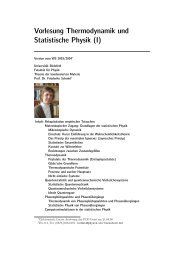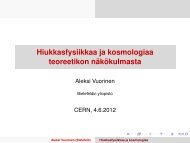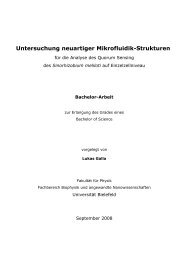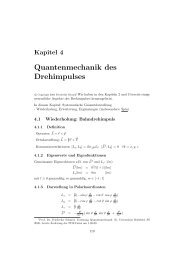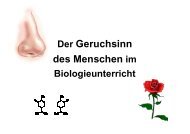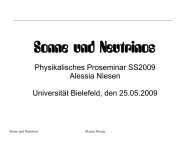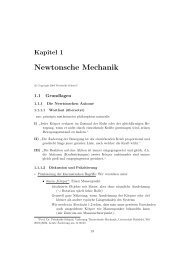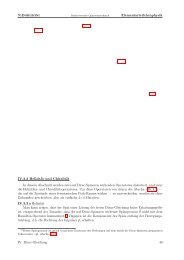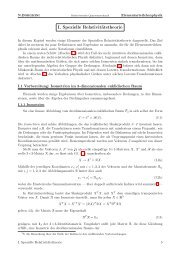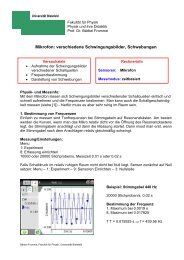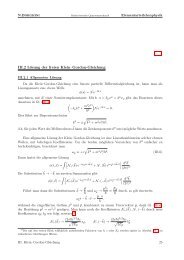Time evolution of reduced phase-space densities. BBGKY hierarchy
Time evolution of reduced phase-space densities. BBGKY hierarchy
Time evolution of reduced phase-space densities. BBGKY hierarchy
You also want an ePaper? Increase the reach of your titles
YUMPU automatically turns print PDFs into web optimized ePapers that Google loves.
N.BORGHINI Topics in nonequilibrium physics<br />
Remark: In the absence <strong>of</strong> interactions, the Hamilton function (III.2) reduces obviously to that <strong>of</strong><br />
an ideal gas.<br />
III.2 <strong>Time</strong> <strong>evolution</strong> <strong>of</strong> <strong>reduced</strong> <strong>phase</strong>-<strong>space</strong> <strong>densities</strong><br />
We now deduce from the Liouville equation (III.1) the equations <strong>of</strong> motion for the <strong>reduced</strong><br />
<strong>phase</strong>-<strong>space</strong> <strong>densities</strong>, first for a system <strong>of</strong> particles in the absence <strong>of</strong> vector potential (Sec. III.2.1),<br />
then for charged particles in a external vector potential (Sec. III.2.2).<br />
Throughout this Section, we shall use the shorthand notations<br />
Fi ≡ − ∇ri V (ri), (III.4a)<br />
Kij ≡ − ∇ri W <br />
ri − rj<br />
, (III.4b)<br />
for the forces upon particle i due to the external potential V and to particle j = i, respectively. In<br />
accordance with Newton’s third law,<br />
Kij = − Kji, (III.4c)<br />
which follows from ∇rj Wij = − ∇ri Wij and the relabeling <strong>of</strong> particles.<br />
III.2.1 System <strong>of</strong> neutral particles<br />
In the absence <strong>of</strong> external vector potential, the Hamilton equations (II.4) with the Hamilton<br />
function (III.2) read<br />
˙ri = ∇pi HN = pi<br />
m , pi<br />
˙ = − ∇ri HN = Fi + <br />
Kij. (III.5)<br />
The first equation simply states that linear momentum and canonical momentum coincide, from<br />
where it follows that the second equation is Newton’s second law.<br />
Accordingly, the Liouville equation (III.1) becomes<br />
∂ρN<br />
∂t +<br />
N<br />
vi · ∇ri ρN +<br />
i=1<br />
N<br />
Fi · ∇pi ρN +<br />
i=1<br />
N<br />
i=1<br />
j=i<br />
N<br />
Kij · ∇pi ρN = 0. (III.6)<br />
III.2.1 a <strong>BBGKY</strong> <strong>hierarchy</strong><br />
✿✿✿✿✿✿✿✿✿✿✿✿✿✿✿✿✿✿✿✿✿✿✿✿✿✿✿<br />
The <strong>reduced</strong> k-particle <strong>phase</strong> density fk(t, r1, p1, . . . , rk, pk) follows from the Γ-<strong>space</strong> probability<br />
density ρN after integrating out the degrees <strong>of</strong> freedom <strong>of</strong> the remaining N − k particles. Similarly,<br />
integrating the Liouville equation (III.6) over the positions and momenta rj, pj <strong>of</strong> N − k particles<br />
gives the <strong>evolution</strong> equation for fk.<br />
This integration relies on a simple fact, namely that the probability density ρN vanishes when<br />
one <strong>of</strong> its <strong>phase</strong>-<strong>space</strong> variables goes to infinity, to ensure the normalization condition (II.1). As a<br />
consequence, integrals <strong>of</strong> the type<br />
<br />
˙ri · ∇ri ρN d 3 <br />
ri or ˙pi · ∇pi ρN d 3 pi<br />
(III.7)<br />
identically vanish. This is here trivial because ˙ ri is independent <strong>of</strong> ri and ˙ pi is independent <strong>of</strong> pi,<br />
so that they can be taken out <strong>of</strong> the respective integrals.<br />
Additionally, we assume that we are allowed to exchange the integration and partial differentiation<br />
operations when needed.<br />
Integrating out N − 1 particles with the proper normalization factor αN,1 = N/(2π) 3 thus<br />
yields for the <strong>evolution</strong> <strong>of</strong> the single-particle <strong>phase</strong>-<strong>space</strong> density (II.18a) the equation<br />
∂f1(t, r1, p1)<br />
∂t<br />
j=1<br />
j=i<br />
+ v1 · ∇r1 f1(t, r1, p1) + F1 · ∇p1 f1(t, r1, p1)<br />
+<br />
N<br />
j=2<br />
N<br />
(2π) 3<br />
<br />
K1j · ∇p1 ρN<br />
<br />
t, {ri}, {pi} d 6(N−1) V = 0.<br />
III. Evolution <strong>of</strong> the <strong>reduced</strong> classical <strong>phase</strong>-<strong>space</strong> <strong>densities</strong> 37



